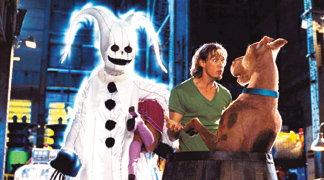Scooby-Doo
Like, where's the plot Scoob?
By Rachel Deahl

How apropos, since Matthew Lillard will be scraping the bottoms
of barrels for roles after a movie like this.
The ultimate Scooby-Doo reference came, of course, in the final moments of Wayne's World when the Scooby-Doo ending is put into play and Mike Myers pulls off the face of Rob Lowe saying, "Hey, it's Old Man Smithers." Unexpected and irrevocably familiar (Scooby-Doo did always end in that manner with a strikingly similar line), that single joke just about milked the 70s cartoon of all its potential humor. Encapsulating the idiocy and shameless repetition the cartoon was known for, the joke summed up why Scooby-Doo was so much fun to watch as a kid and irrevocably laughable as an adult. So what happens when you make an entire film about an old TV show where all the jokes have, essentially, been used up? You end up with the debacle that Warner Brothers is selling right now: dull and humorless, Scooby-Doo (the movie) has absolutely nothing to offer.
For those who were not devotees of the cartoon, Scooby-Doo followed the travails of a motley bunch of teens that drove around in a bus and solved mysteries. Set sometime in the 70s, the crew consisted of Fred (handsome and stiff), Daphne (hot and helpless), Velma (dorky and smart), Shaggy (idiotic and scruffy) and Scooby (Shaggy's equally dumb talking canine buddy). Essentially Shaggy and Scooby (the scaredy-cats of the bunch) would drift off and get into trouble while the rest of the gang would solve the mystery and ultimately save their hapless friends. Each episode had only one other character in it, so the gang would always be solving the same mystery-and always revealing that other character to be playing a ghost in disguise. Like The Brady Bunch Movie, Scooby-Doo riffs on the prototypes of the characters, but with much less bite. Almost strictly for a G audience, Scooby-Doo doesn't do as much with the latter interpretations of Shaggy and Scooby as potheads with the munchies ("like" is the one recurring word in Shaggy's speech and he and the dog are always hungry), or of Velma as a lesbian who has the hots for Daphne as expected.
Unfortunately, Scooby-Doo is played much like the original cartoons, only with human stand-ins for the former two-dimensional crowd. The result is an idiotic and lifeless barrage of "ruh-rohs" and pratfalls. If there needed to be a Scooby-Doo movie, it would've been much preferable as a cartoon. The irony with this human feature is that it makes fun of the simple nature of the original cartoon far less than it copies it. The few jokes that they do throw in are expected.
As for the casting, Freddie Prinze Jr. and his real-life sweetie Sarah Michelle Gellar are watchable as the self-absorbed Fred and Daphne (both milking their off-screen personas more than acting). Matthew Lillard appears the most able in the cast with his dead-on imitation of Shaggy (at first he seems to have both the voice and the unmistakable hunched swagger down). But, after awhile, Lillard's goofy facial expressions become grating and you're overwhelmed with the feeling that you'd rather be watching the Shaggy of yore. The most disappointing member of the cast though, is Scooby. A computer-generated image of the lovable pooch, Scooby is almost unwatchable as he looks so contrived and fake; you can almost see the rest of the cast timing their actions to mimic a dog that ain't really there.
HOME | THIS ISSUE | ACE ARCHIVES